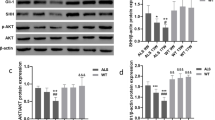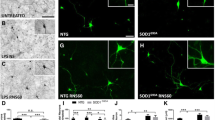Abstract
We have previously demonstrated that primary cilia on spinal motor neurons are reduced in G93A SOD1 (mSOD) mice, a mouse model of amyotrophic lateral sclerosis (ALS). Sonic hedgehog (Shh) signaling involves the primary cilium and Shh has been shown to be cytoprotective in models of other neurodegenerative diseases. Thus, the Shh signaling pathway may bear further study in ALS. Accordingly, we established that interference with the Shh pathway (with the Shh antagonist cyclopamine or with miRNA 3245p) sensitized HT22 cells, while augmentation of the Shh pathway (with Shh or the Shh agonist purmorphamine) protected cells against hydrogen peroxide (H2O2) challenge. We ectopically expressed mSOD, human wild-type SOD1 (wtSOD), or an empty vector in HT22 cells. Compared to empty vector, wtSOD decreased cell death and mSOD increased cell death in response to H2O2 challenge. Treatment with cyclopamine or miRNA 3245p sensitized all three transfections to H2O2 challenge. Treatment with recombinant human Shh or purmorphamine decreased cell death after H2O2 challenge, an effect more pronounced in mSOD cells. Compared with empty vector, overexpression of wtSOD increased Shh and Gli transcript levels and increased activity in a Gli-responsive reporter assay. Overexpression of mSOD did not change Shh transcript levels, but decreased Gli transcript levels, especially Gli3, and reduced activity in a Gli reporter assay. These results suggest that overexpression of mSOD but not wtSOD reduces signaling in the Shh pathway and renders mSOD cells more susceptible to H2O2 challenge, and that treatment with Shh or Shh agonists is cytoprotective to mSOD cells. Shh or Shh agonists merit further consideration as potential therapy in ALS.





Similar content being viewed by others
References
ALS Online Genetic Database. http://alsod.iop.kcl.ac.uk/
Barber SC, Shaw PJ (2010) Oxidative stress in ALS: key role in motor neuron injury and therapeutic target. Free Radic Biol Med 48:629–641
Bond C, Tang Y, Podlasek CA (2008) Neural influences on sonic hedgehog and apoptosis in the rat penis. Biol Reprod 78:947–956
Briscoe J (2009) Making a grade: sonic hedgehog signalling and the control of neural cell fate. EMBO J 28:457–465
Cai C, Thorne J, Grabel L (2008) Hedgehog serves as a mitogen and survival factor during embryonic stem cell neurogenesis. Stem Cells (Dayton, Ohio) 26:1097–1108
Calcutt NA, Allendoerfer KL, Mizisin AP, Middlemas A, Freshwater JD, Burgers M, Ranciato R, Delcroix JD, Taylor FR, Shapiro R, Strauch K, Dudek H, Engber TM, Galdes A, Rubin LL, Tomlinson DR (2003) Therapeutic efficacy of sonic hedgehog protein in experimental diabetic neuropathy. J Clin Invest 111:507–514
Chari NS, McDonnell TJ (2007) The sonic hedgehog signaling network in development and neoplasia. Adv Anat Pathol 14:344–352
Cheng SY, Bishop JM (2002) Suppressor of Fused represses Gli-mediated transcription by recruiting the SAP18-mSin3 corepressor complex. Proc Natl Acad Sci USA 99:5442–5447
Cohen MM Jr (2010) Sonic hedgehog signaling update. Am J Med Genet A 152A(8):1875–1914
Dass B, Iravani MM, Huang C, Barsoum J, Engber TM, Galdes A, Jenner P (2005) Sonic hedgehog delivered by an adeno-associated virus protects dopaminergic neurones against 6-OHDA toxicity in the rat. J Neural Transm 112:763–778
Dellovade T, Romer JT, Curran T, Rubin LL (2006) The hedgehog pathway and neurological disorders. Ann Rev Neurosci 29:539–563
Farzan SF, Singh S, Schilling NS, Robbins DJ (2008) The adventures of sonichedgehog in development and repair: III. Hedgehog processing and biological activity. Am J Physiol 294:G844–G849
Ferrante RJ, Shinobu LA, Schulz JB, Matthews RT, Thomas CE, Kowall NW, Gurney ME, Beal MF (1997) Increased 3-nitrotyrosine and oxidative damage in mice with a human copper/zinc superoxide dismutase mutation. Ann Neurol 42:326–334
Ferretti E, De Smaele E, Miele E, Laneve P, Po A, Pelloni M, Paganelli A, Di Marcotullio L, Caffarelli E, Screpanti I, Bozzoni I, Gulino A (2008) Concerted microRNA control of Hedgehog signalling in cerebellar neuronal progenitor and tumour cells. EMBO J 27:2616–2627
Hall ED, Andrus PK, Oostveen JA, Fleck TJ, Gurney ME (1998) Relationship ofoxygen radical-induced lipid peroxidative damage to disease onset and progression in a transgenic model of familial ALS. J Neurosci Res 53:66–77
Humke EW, Dorn KV, Milenkovic L, Scott MP, Rohatgi R (2010) The output of Hedgehog signaling is controlled by the dynamic association between suppressor of fused and the Gli proteins. Genes Dev 24:670–682
Hurtado-Lorenzo A, Millan E, Gonzalez-Nicolini V, Suwelack D, Castro MG, Lowenstein PR (2004) Differentiation and transcription factor gene therapy in experimental Parkinson’s disease: sonic hedgehog and Gli-1, but not Nurr-1, protect nigrostriatal cell bodies from 6-OHDA-induced neurodegeneration. Mol Ther 10:507–524
Jiao J, Chen DF (2008) Induction of neurogenesis in nonconventional neurogenic regions of the adult central nervous system by niche astrocyte-produced signals. Stem cells (Dayton, Ohio) 26:1221–1230
Kondo T, Johnson SA, Yoder MC, Romand R, Hashino E (2005) Sonic hedgehog and retinoic acid synergistically promote sensory fate specification from bone marrow-derived pluripotent stem cells. Proc Natl Acad Sci USA 102:4789–4794
Lanius RA, Krieger C, Wagey R, Shaw CA (1993) Increased [35S]glutathione binding sites in spinal cords from patients with sporadic amyotrophic lateral sclerosis. Neurosci Lett 163:89–92
Lauth M, Toftgard R (2007) Non-canonical activation of GLI transcription factors: implications for targeted anti-cancer therapy. Cell Cycle (Georgetown, TX) 6:2458–2463
Lee M, Hyun DH, Halliwell B, Jenner P (2001) Effect of overexpression of wild-type and mutant Cu/Zn-superoxide dismutases on oxidative stress and cell death induced by hydrogen peroxide, 4-hydroxynonenal or serum deprivation: potentiation of injury by ALS-related mutant superoxide dismutases and protection by Bcl-2. J Neurochem 78:209–220
Li L, Li Y, Ji X, Zhang B, Wei H, Luo Y (2008) The effects of retinoic acid on the expression of neurogranin after experimental cerebral ischemia. Brain Res 1226:234–240
Ma X, Peterson R, Turnbull J (2011) Adenylyl cyclase type 3, a marker of primary cilia, is reduced in primary cell culture and in lumbar spinal cord in situ in G93ASOD1 mice. BMC Neurosci 12(1):71
Maher P, Davis JB (1996) The role of monoamine metabolism in oxidative glutamate toxicity. J Neurosci 16:6394–6401
Miao N, Wang M, Ott JA, D’Alessandro JS, Woolf TM, Bumcrot DA, Mahanthappa NK, Pang K (1997) Sonic hedgehog promotes survival of specific CNS neuron populations and protects these cells from Toxic insults in vitro. J Neurosci 17(15):5891–5899
Mir M, Asensio VJ, Tolosa L, Gou-Fabregas M, Soler RM, Llado J, Olmos G (2009) Tumor necrosis factor alpha and interferon gamma cooperatively induce oxidative stress and motoneuron death in rat spinal cord embryonic explants. Neuroscience 162:959–971
Morgan DM (1998) Tetrazolium (MTT) assay for cellular viability and activity. Methods Mol Biol (Clifton, NJ) 79:179–183
Palma V, Lim DA, Dahmane N, Sanchez P, Brionne TC, Herzberg CD, Gitton Y, Carleton A, Alvarez-Buylla A, Ruiz i Altaba A (2005) Sonic hedgehog controls stem cell behavior in the postnatal and adult brain. Development (Cambridge, England) 132:335–344
Pasinelli P, Brown RH (2006) Molecular biology of amyotrophic lateral sclerosis: insights from genetics. Nature Rev 7:710–723
Pedersen WA, Fu W, Keller JN, Markesbery WR, Appel S, Smith RG, Kasarskis E, Mattson MP (1998) Protein modification by the lipid peroxidation product 4-hydroxynonenal in the spinal cords of amyotrophic lateral sclerosis patients. Ann Neurol 44:819–824
Rosen DR (1993) Mutations in Cu/Zn superoxide dismutase gene are associated with familial amyotrophic lateral sclerosis. Nature 362(6415):59–62
Rothstein JD (2009) Current hypotheses for the underlying biology of amyotrophic lateral sclerosis. Ann Neurol 65(Suppl 1):S3–S9
Schiffer D, Fiano V (2004) Astrogliosis in ALS: possible interpretations according to pathogenetic hypotheses. Amyotroph Lateral Scler Other Motor Neuron Disord 5:22–25
Shaw IC, Fitzmaurice PS, Mitchell JD, Lynch PG (1995) Studies on cellular free radical protection mechanisms in the anterior horn from patients with amyotrophic lateral sclerosis. Neurodegeneration 4:391–396
So PL, Yip PK, Bunting S, Wong LF, Mazarakis ND, Hall S, McMahon S, Maden M, Corcoran JP (2006) Interactions between retinoic acid, nerve growth factor and sonic hedgehog signalling pathways in neurite outgrowth. Dev Biol 298:167–175
Stanton BZ, Peng LF (2010) Small-molecule modulators of the sonic hedgehog signaling pathway. Mol Biosyst 6:44–54
Stecca B, Ruiz i Altaba A (2002) The therapeutic potential of modulators of the hedgehog–Gli signaling pathway. J Biol 1:9
Stenkamp DL, Satterfield R, Muhunthan K, Sherpa T, Vihtelic TS, Cameron DA (2008) Age-related cone abnormalities in zebrafish with genetic lesions in sonic hedgehog. Invest Ophthalmol Vis Sci 49:4631–4640
Tsuboi K, Shults CW (2002) Intrastriatal injection of sonic hedgehog reduces behavioral impairment in a rat model of Parkinson’s disease. Exp Neurol 173:95–104
Wang Y, Imitola J, Rasmussen S, O’Connor KC, Khoury SJ (2008) Paradoxical dysregulation of the neural stem cell pathway sonic hedgehog–Gli1 in autoimmune encephalomyelitis and multiple sclerosis. Ann Neurol 64:417–427
Acknowledgment
The authors wish to thank Mr. David Hunt, whose generosity has helped fund this research.
Author information
Authors and Affiliations
Corresponding author
Electronic supplementary material
Below is the link to the electronic supplementary material.
Fig. S1
Relative transfection efficiency in HT22 cells. 24 h after transfection, three wells per transfection group were used to quantitate GFP florescence. Five fields per well were counted, and a minimum of 1,000 cells scored. Data represent the mean ± SD (DOC 1049 kb)
Fig. S2
The relative percent viability of treated or transfected HT22 cells in the absence of H2O2 challenge. 24 h post-treatment or transfection, cellular viability was measured via the MTT assay. Data represents the mean ± SD (DOC 71 kb)
ESM 3
(DOC 48 kb)
Rights and permissions
About this article
Cite this article
Peterson, R., Turnbull, J. Sonic Hedgehog is Cytoprotective against Oxidative Challenge in a Cellular Model of Amyotrophic Lateral Sclerosis. J Mol Neurosci 47, 31–41 (2012). https://doi.org/10.1007/s12031-011-9660-x
Received:
Accepted:
Published:
Issue Date:
DOI: https://doi.org/10.1007/s12031-011-9660-x




